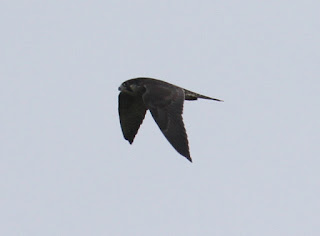Autumn in Norfolk? Check!
North-easterly winds to blow in rare migrants? Check!
Rain and drizzle to ground them? Check!
Rare birds? Errrr...
So, with such great weather to blow in some really good birds, why have I spent the day walking round looking at empty bushes and birdless skies?
The weather looked great for blowing in some birds. North-easterly winds, with heavy overnight rain, easing off a little by dawn. Normally, there'd be loads of birds along the coast with heavy visible-migration and lots of grounded migrants, but the birds just weren't there. A look at the weather map shows lots of cloud extending across the north sea and into Holland and Denmark, so perhaps those bird are grounded elsewhere on the continent and never got to set off across the North Sea. There were a few Godscrest, one Chiffchaff and quite a few Redwing and Song Thursh, but that's about it.
One bird that did intrigue me was a large falcon that I had at Waxham. It put everything up in the surrounding fields and flew past me, heading out towards the sea. I thought it was a Peregrine at first, but then thought it looked a bit dark and narrow-winged so I grabbed the camera and rattled off a bunch of photos. At the time, I did muse over the bird's appearance to Lanner, but I think it's 'just' a Peregrine. But it's very dark, especially on the underwing coverts and breast, giving it an appearance very similar to that of the North American form
anatum. But then I think that an
anatum should show a wider mustacial stripe and less white on the cheeks. Anyway, it's an interesting bird..
Post script: Dick Forsman has kindly commented as follows:
"I've never seen a "normal" Peregrine this dark
myself, but certainly some brookei and some Peale's from N Pacific could
look like this.
With
all the escaped falconer's birds flying around I wouldn't get too
excited about it, and still, Peregrines are hugely variable anyway.
Whether an escape or not , it undeniably looks very exotic!"


















































